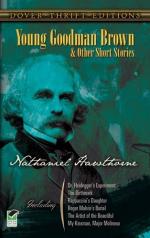|
This section contains 8,964 words (approx. 30 pages at 300 words per page) |

|
SOURCE: “Deodat Lawson's Christ's Fidelity and Hawthorne's ‘Young Goodman Brown,’” in Essex Institute Historical Collections, Vol. 104, No. 4, October, 1968, pp. 349-70.
In the following essay, Cohen contends that Deodat Lawson's Christ's Fidelity, a work about the Salem witchcraft trials in 1692, inspired Hawthorne to write “Young Goodman Brown.”
Despite much praise and many fine words expended on Hawthorne's “Young Goodman Brown,” interpretations of this well-wrought tale have varied as widely as the critics and their personal biases. The abundant ambiguities present in the story yield opportunity to all: those who would see Hawthorne as confirming Calvinism's central doctrine of man's innate depravity, others who view him as rejecting the same tenet, some who would apply a latter-day symbolism involving phallic pine trees and sexual guilt, and still others who would by expert juggling of old ideas in new semantic dress convey the impression that an original interpretation is being offered...
|
This section contains 8,964 words (approx. 30 pages at 300 words per page) |

|


